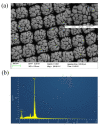Rapid Detection of Carbendazim Residue in Apple Using Surface-Enhanced Raman Scattering and Coupled Chemometric Algorithm
- PMID: 35564010
- PMCID: PMC9103909
- DOI: 10.3390/foods11091287
Rapid Detection of Carbendazim Residue in Apple Using Surface-Enhanced Raman Scattering and Coupled Chemometric Algorithm
Abstract
In order to achieve rapid and precise quantification detection of carbendazim residues, surface-enhanced Raman spectroscopy (SERS) combined with variable selected regression methods were developed. A higher sensitivity and greater density of "hot spots" in three-dimensional (3D) SERS substrates based on silver nanoparticles compound polyacrylonitrile (Ag-NPs @PAN) nanohump arrays were fabricated to capture and amplify the SERS signal of carbendazim. Four Raman spectral variable selection regression models were established and comparatively assessed. The results showed that the bootstrapping soft shrinkage-partial least squares (BOSS-PLS) method achieved the best predictive capacity after variable selection, and the final BOSS-PLS model has the correlation coefficient (RP) of 0.992. Then, this method used to detect the carbendazim residue in apple samples; the recoveries were 86~116%, and relative standard deviation (RSD) is less than 10%. The 3D SERS substrates combined with the BOSS-PLS algorithm can deliver a simple and accurate method for trace detection of carbendazim residues in apples.
Keywords: Ag-NPs @PAN-nanohump arrays; apple; bootstrapping soft shrinkage-partial least squares (BOSS-PLS); carbendazim; surface-enhanced Raman spectroscopy (SERS).
Conflict of interest statement
The authors declare that they have no known competing financial interests or personal relationships that could have appeared to influence the work reported in this paper.
Figures




References
-
- Huang Y.P., Lu R.F., Chen K.J. Detection of internal defect of apples by a multichannel Vis/NIR spectroscopic system. Postharvest Biol. Technol. 2020;161:111065. doi: 10.1016/j.postharvbio.2019.111065. - DOI
-
- Yao Y., Wen Y., Zhang L., Wang Z., Zhang H., Xu J. Electrochemical recognition and trace-level detection of bactericide carbendazim using carboxylic group functionalized poly(3,4-ethylenedioxythiophene) mimic electrode. Anal. Chim. Acta. 2014;831:38–49. doi: 10.1016/j.aca.2014.04.059. - DOI - PubMed
Grants and funding
LinkOut - more resources
Full Text Sources
Miscellaneous

